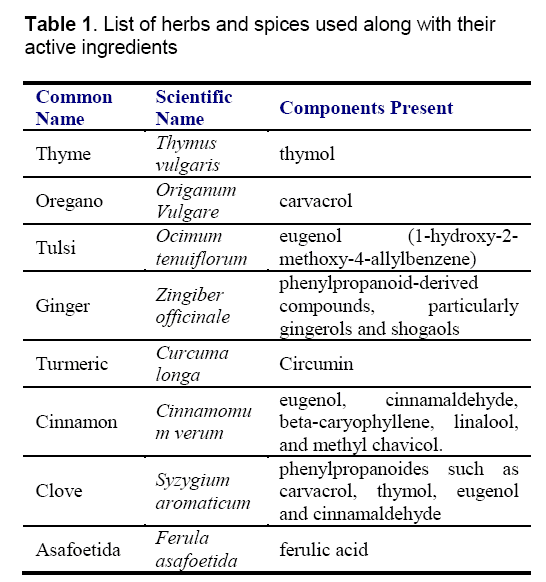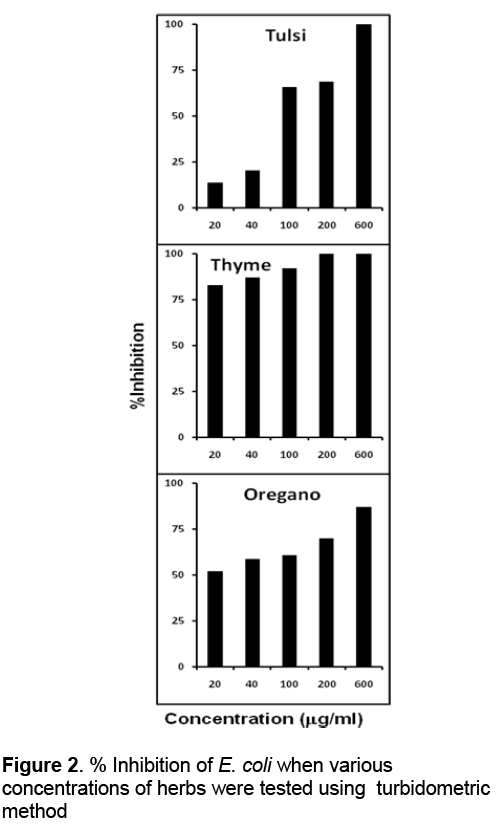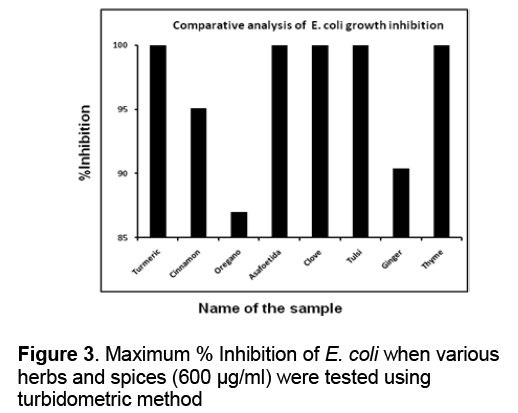Antibacterial Effect of Herbs and Spices Extract on Escherichia coli
Venugopal Amrita, Dasani Sonal, Rai Shalini
Department of Life Sciences, Kishinchand Chellaram College, D.W Road, Churchgate, Mumbai-400 020 India
- Corresponding Author:
- Tel: +919820291092
E-mail: sonaldasani@yahoo.com
Abstract
Escherichia coli are the most commonly present bacterium in the human intestine, which helps in preventing the entry of pathogenic microorganisms. E. coli are non-pathogenic in normal conditions, but if present in excess, will become causative agent of various diseases like urinary tract infection, diarrhoea, vomiting etc. With increasing resistance of microorganisms to antibiotics, there is a shift of choice from allopathic to ayurvedic and naturopathy, where herbs and spices are very common ingredients of medicines. Herbs and spices are used in Indian recipes as they impart aroma and flavour to it. Most of the studies performed to check sensitivity of microorganisms for various herbs and spices involve extraction of the active component(s) with some organic solvents. However, when these plant products are used as ingredients of food, the effectiveness of extracts using organic solvents should not be a criterion. In the present study, frequently used herbs and spices are selected, their extracts are made using distilled water and tested for its antimicrobial effect against E. coli the most common intestinal non pathogenic organism. The antibacterial effect of various herbs and spices were evaluated using various methods. All the herbs and spices tested were able to inhibit E. coli growth, but Thyme (herb) and Turmeric (spice) were found to be most effective against E. coli.
Keywords
Escherichia coli; antibacterial activity; turbidometry; Thymus serpyllum; Curcuma longa.
1. Introduction
Food borne diseases have always been a major concern in both developing and developed countries [1]. Campylobacter jejuni, Staphylococcus aureus, Salmonella (over 1600 types), Escherichia coli O157:H7, streptococci, etc. are some of the major bacterial species that causes food borne diseases [2]. E. coli are the most commonly found bacterium in the human intestinal tract. Under normal conditions, its presence is conducive to digestive processes. But when present in excess or in virulent form it causes diseases. Virulent strains of E. coli can cause gastroenteritis, urinary tract infections, neonatal meningitis etc.[1].
With increasing use of drugs, microorganisms are attaining resistance to commonly used antibiotics, which leads to downfall of effectiveness of conventional medicines and therefore, search for new antimicrobial agents has become necessary. Traditional medicines have been used for many centuries by a substantial proportion of the population of India [2]. The interest in the study of medicinal plants as a source of pharmacologically active compounds has increased worldwide. It is recognized that in developing countries like India, plants are the main medicinal source to treat infectious diseases [3]. Approximately 20% of the plants found in the world have been subjected to pharmacological or biological test, and a substantial number of new antibiotics introduced in the market are obtained from natural or semi-synthetic resources [4].
The active ingredients of plants against microorganisms are mostly some of the secondary metabolites (i.e. alkaloids, glycosides etc.) that are present in abundance in herbs and spices commonly used in Indian food preparations. Herbs are small plants used by human being for various purposes like medicines, food supplements for imparting flavour or scant, and as a part of offerings to God since beginning of civilization [5].
Spices have been defined as plant substances from indigenous or exotic origin, aromatic or with strong taste, used to enhance the taste of foods [6]. Spices include leaves (bay, mint, rosemary, coriander, laurel, oregano), flowers (clove), bulbs (garlic, onion), fruits (cumin, red chilli, black pepper), stems (coriander, cinnamon), rhizomes (ginger) and other plant parts [7]. The importance of spices can be found not only in their flavouring, but also in their medicinal, preservative and antioxidant properties [8]. Being plants, the natural foodstuffs, spices appeal to consumers who tend to question the safety of synthetic additives [9,10]. Antimicrobial properties of spices have been documented in ancient literature and the interest continues to the present [11-14]. However, little information is available emphasizing the preservative and antimicrobial properties of spices [15].
The aim of this study is to test the antibacterial effect of various herbs and spices on Escherichia coli. The herbs and spices used in traditional Indian food preparations (Table 1) are selected for the study with the aim to spread the awareness of the utility of herbs and spices among the masses with the following objectives.

• Collection and identification of herbs and spices samples;
• Extraction of samples using distilled water;
• Optimization of Inoculums concentration (E. coli);
• Standardization and antimicrobial assay of herbs and spices using various methods (i.e. Paper disc method, agar ditch method, Turbidometry).
2. Materials and Methods
Preparation of samples
The leaves (1 g) of the various herbs were overnight soaked in water and ground with mortar and pestle along with 5 ml of distilled water. The samples were then centrifuged (5000 RPM, 10 min) and the supernatants obtained were used as an extract. Fresh samples of the spices were ground with 5 ml of distilled water and centrifuged at 5000 RPM for 10 min. The supernatant was separated and the samples were washed twice using distilled water. The pooled supernatants were used as sample (extract) and represented as μg/ml.
Preparation of inoculums (E. coli culture)
A loop full of pure culture is inoculated in saline and the optical density is adjusted to 0.1 using spectrophotometer. This saline suspension is used for the turbidometric method. For paper disc and Agar ditch method dense E. coli culture inoculated in N- broth was used.
Turbidometric Method
The inoculum was inoculated to N- broth with different concentration of sample (20-600 μg/ml). The tubes were incubated for 24 hrs at 37°C and optical densities were recorded at 540 nm. Each concentration of all the samples was analyzed in duplicate along with the controls and their mean is used to calculate % inhibition, which is plotted in the graph against concentration.
Paper Disc Method
The inoculum (100μl) was spreaded uniformly in N-agar plates with the help of glass spreader and kept for five minutes. Pre- sterilized paper discs were dipped into different samples (herb and spice extracts) placed in inoculated plates. The plates were incubated for 24 hrs at 37°C and size of clear zones developed surrounding each disc was measured by scale to the nearest mm and were plotted in the graph.
Agar Ditch Method
With the help of cork borer four ditches were made per plate in the pre inoculated N-agar plates. Different extracts were added to these ditches (100μl) and plates were incubated at 37°C. After 24 hrs diameter of clear zone produced surrounding the ditches were measured to the nearest mm with the help of scale and were presented in the graph.
Statistical Analysis
The data of mean % inhibition were subjected Single factor analysis of variance (ANOVA) and unpaired t- test using variance. The Level of significance of difference and calculated values are discussed.
3. Results and Discussion
Traditionally, herbs and spices are part of routine Indian food preparations as they make food appealing by providing better appearance, smell and taste. As mentioned in ‘Atharva veda’ these herbs and spices have healing, soothing and rejuvenating properties. Some of the common herbs and spice used are chilli, clove, coriander, mint, garlic, ginger, turmeric, tulsi, cinnamon, tamarind, asafoetida etc. ‘Ayurveda’ the indigenous system of Indian medicine, uses a large number of spices in combinations as preventive and curative medicines [16].
There are number of reports available in literature stating the sensitivity of various bacteria towards these herbs and spices used in food preparations [17]. Most of these studies involve extraction of the active component in the herbs and spices using organic solvents. But as an ingredient of food, the antibacterial properties using organic solvent extraction should not be a criterion; therefore, in the present study the commonly used herbs and spices extracts are made with distilled water and tested for its antimicrobial effect against E. coli.
There are various direct and indirect methods used to enumerate concentration of microorganisms from variety of samples [18] like microscopic count, total count, spread plate for viable count etc. In the present study three of the methods were used to check antimicrobial activity of various spices and herbs and to have an idea about most suitable method for the similar kind of analysis. Viz. Turbidometric method, Paper disc method and Agar ditch method.
Samples were analysed using turbidometric method and mean % inhibition in growth of E. coli against various concentrations (20-600 μg/ml) of different spices is represented in Figure 1. All the samples showed increase in % inhibition of growth with increase in concentration. However, Turmeric was found to be most effective in inhibiting growth of E. coli even at 20μg/ml i.e. lowest concentration used followed by clove and cinnamon. All the spices showed statistically significant difference in % inhibition (P< 0.05).
Apart from antimicrobial activity, spices used for present study has properties like analgesic, carminative, digestive, protective etc. Asafoetida is used in treating chronic bronchitis and whooping cough. It is used in counteracting intestinal flatulence by increases the levels of detoxifying enzymes in the body [20]. Ginger is commonly used to increase digestion, treat joint pains, common cold and throat infections and is also known to boost immunity [19]. Turmeric is a common ingredient present in most Indian food preparations. It is a known fact that turmeric prevents Alzheimer’s disease which is supported by the fact that Indian population has a lower percentage of people suffering from this disease as compared to western countries [20]. Cloves are used in Ayurveda, Chinese medicine and Western herbalism. Cloves are used as a carminative, to increase hydrochloric acid in the stomach and to improve peristalsis [21]. It is also used in dentistry where the essential oil of clove is used as anodyne for dental emergencies [22,23].
Figure 2 represents % inhibition in growth of E. coli against various concentrations (20-600 μg/ml) of different herbs. All the three herbs tested showed increase in % inhibition of growth along with concentration. Thyme was found to be most effective followed by oregano and tulsi. Unlike oregano and thyme, tulsi showed considerable inhibition in E. coli growth only at higher concentrations. Tulsi extracts are used in ayurvedic remedies for common colds, headaches, stomach disorders, inflammation, heart disease, various forms of poisoning, and malaria [24]. Our results are contradictory to the literature According to which tulsi is a plant with maximum antibacterial compounds. Analysis of variance performed amongst different herbs showed statistically significant difference (P<0.05) amongst herbs. A tea made by infusing the herbs like tulsi, mint etc. in water can be use for the prevention and cure of cough, bronchitis etc. [1].
Medicinally thyme is used for respiratory infections [1]. Thyme showed considerably high inhibition in growth of E. coli even at lower concentrations (20 μg/ml, Figure 2). Oregano is consumed orally for the treatment of colds, influenza, mild fevers, indigestion, stomach upsets and painful menstruation. The predominant constituent of oregano that is responsible for its antimicrobial activity is carvacol [25]. In the present study, oregano was able to inhibit the growth of E. coli by 50 % at lower concentrations, but was not able to inhibit the growth completely even with 600 μg/ml concentration.
Above results showed that amongst all the spices and herbs used E. coli was found to be most sensitive to turmeric and Thyme, respectively. Usually in food preparation the concentrations used of herbs and spices is relatively high. For the comparison of relative effectiveness, in the present study, 600μg/ml was used by turbidometric method and results obtained are represented in Figure 3.
Except ginger, oregano and cinnamon all the samples showed 100% inhibition in growth of E. coli. However, difference in % inhibition with various concentrations demonstrated by various samples was found to be statistically highly significant (P<0.001), suggesting that water soluble antimicrobial component is different in different herbs and spices. Since, turbidometric method gives the total count, the results were confirmed using methods used for viable count (Paper disc and Agar cup method).
Considering the above results, it can be suggested that addition of herbs and spices to the food preparations helps to keep a check on the concentration Escherichia coli in the body. Tulsi and turmeric are used as most important food additives with antimicrobial activities in Indian recipes, however, our results suggest that addition of thyme and oregano will also be helpful for the same.
References
- Mead P.S., Slutsker L., Dietz V., et al. (1999) Food related illness and dead in the United States. Emerging Infectious Diseases, 5: 607-625.
- Consumer information from USDA (1997) Food Safety and Inspection Service, Food Safety and Consumer Education Office.
- Pei S.J. (2001) Ethnobotanical approaches oftraditional medicine studies: Some experiences from Asia. Pharmaceutical Biology, 39: 74-79.
- Mothana R.A., Lindequist U. (2005) Antimicrobial activity of some medicinal plants of the island Soqotra, Journal of Ethno pharmacology, 96(1-2): 177-181.
- Tenover F.C., Weige L.M., Appelbaum P.C., et al. (2004) Vancomycin-Resistant Staphylo coccus aureus Isolate from a patient in Pennsylvania. Antimicrob. Agents Chemother, 48(1): 275-280.
- Germano P.M.L., Germano M.I.S. (1998) Importância e riscos das especiarias. Higiene Alimentar, 12: 239-312.
- Shelef L.A., (1983) Antimicrobial effects of spices. Journal of Food Safety, 6: 29-44.
- Darmadji P., Izumimoto M., Ketaoka K., (1993) Antibacterial effect of spices on fermented meat. Agrosains, 83: 1-6.
- Farag R.S., Daw Z.Y., Hewed F.M., et al. (1989) Antimicrobial activity of some Egyptian spice oils. Journal of Food Protection, 52: 665–667.
- Sagdiç O., Karahan A.G., Ozcan M. et al. (2003) Effect of some spice extracts on bacterial inhibition, Food Science and Technology International, 9(5): 353-358.
- Shami M.A., Fadl F.A., Sirry A.R., et al. (1985) Antifungal property of garlic, clove juice compared with fungicidal treatment against Fusarium with watermelon. Egyptian Journal of Phytopathology, 17: 55-62
- Akgül A., Kivanç M. (1988) Inhibitory effects of six Turkish thyme-like spices on some common food-borne bacteria. Nahrung, 32(2): 201-203.
- Cosentino S., Tuberoso C.I.G., Pisano B., et al. (1999) In-vitro antimicrobial activity and chemical composition of Sardinian thymus essential oils, Letters in Applied Microbiology, 29: 130-135.
- Ristori C.A., Pereira M.S., Gelli D.S. (2002) O efeito da pimenta do reino moída frente a contaminação in vitro com Salmonella rubislaw. Revista do Instituto Adolfo Lutz, 61: 131-133.
- Arora D.S., Kaur J. (1999) Antimicrobial activity of spices, International Journal of Antimicrobial Agents, 12(3): 257-262.
- Nair R., Kalariya T., Chanda S. (2004) Antibacterial activity of some selected Indian medicinal flora, Turk Journal, 29: 41-47.
- Lewis R. (1995) The rise of antibiotic-resistant infections, FDA Consumer Magazine, 29(7).
- Pelczar M.J., Chan E.C.S., Kreig N.R. (2000) Microbiology - 5th Edition, Tata Mac Graw Hill Publishing Co. Ltd, New- York, pp.137-386.
- Indu M.N., Hathaja A.M., Abirosh C., et al. (2006) Antimicrobial activity of some of the south-Indian spices against serotypes of Escherichia coli, Salmonella, Listeria monocytogenes and Aeromonas hydrophila, Brazilian Journal of Microbiology, 37(2): 153-158.
- Busatta C., Mossi A.J., Rodrigues M.R., et al. (2007) Evaluation of Origanum vulgare essential oil as antimicrobial agent in sausage, Brazilian Journal of Microbiology, 38(4): 610-616.
- Phyllis B., James B. (2000) Prescription for Nutritional Healing, 4th Edition. Penguin Putnam; 3rd edition ISBN-10: 1583331611; ISBN-13: 978-1583331613.
- Cai L., Wu C.D. (1996) Compounds from Syzygium aromaticum possessing growth inhibitory activity against oral pathogens, Journal of Natural Production, 59(10): 987-990.
- Prashar A., Locke I.C., Evans C.S., (2006) Cytotoxicity of clove (Syzygium aromaticum) oil and its major components to human skin cells. Cell Proliferation, 39: 241-248.
- Sharma R. (2006) Easy and Early Cure – Home Remedies. Manoj Publications.
- Itir D., Evrendilek G.A., (2004) Chemical Compositions and antibacterial effects of essential oils of Turkish Oregano (Origanum minutiflorum), Bay Laurel (Laurus nobilis), Spanish Lavender (Lavandula stoechas L.), and Fennel (Foeniculum vulgare) on common foodborne pathogens, Journal of Agriculture and Food Chemistry, 52(25): 8255-8260.

Open Access Journals
- Aquaculture & Veterinary Science
- Chemistry & Chemical Sciences
- Clinical Sciences
- Engineering
- General Science
- Genetics & Molecular Biology
- Health Care & Nursing
- Immunology & Microbiology
- Materials Science
- Mathematics & Physics
- Medical Sciences
- Neurology & Psychiatry
- Oncology & Cancer Science
- Pharmaceutical Sciences



